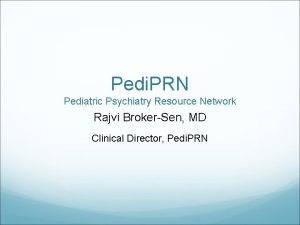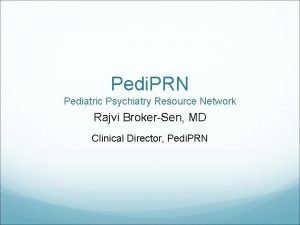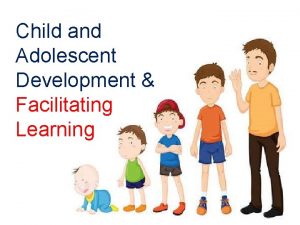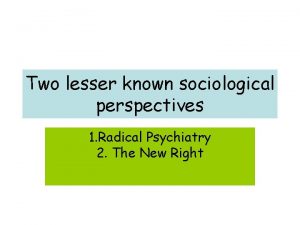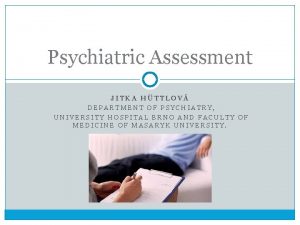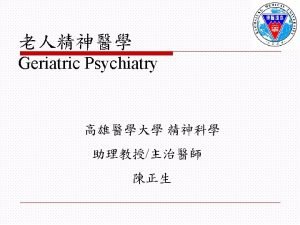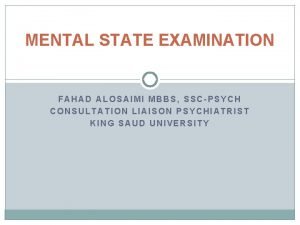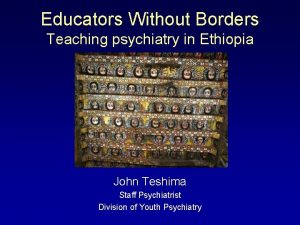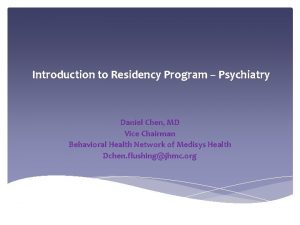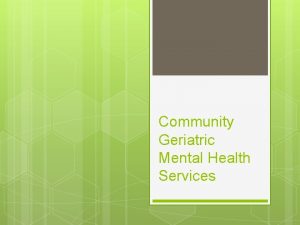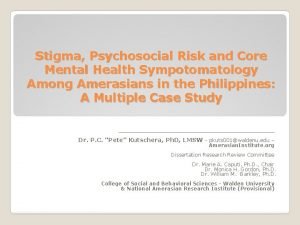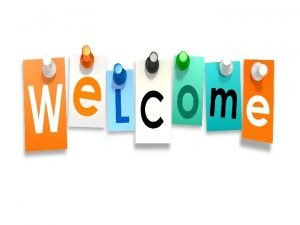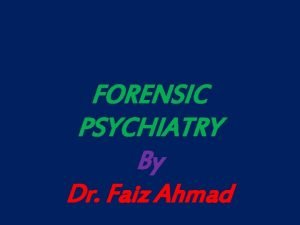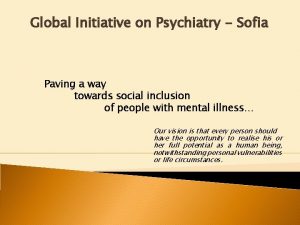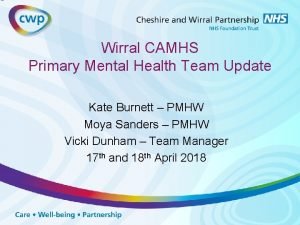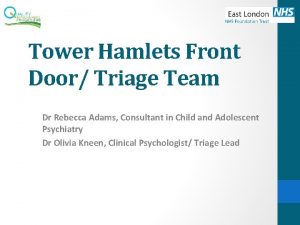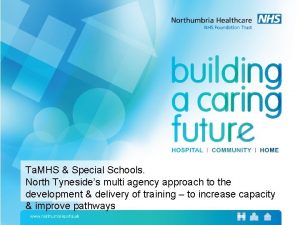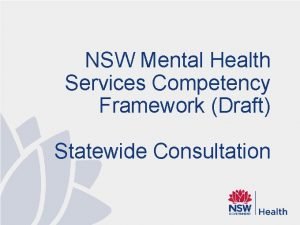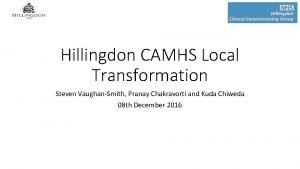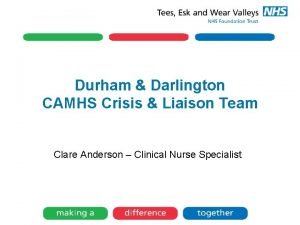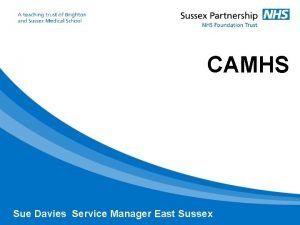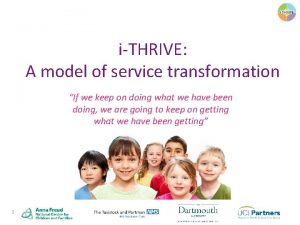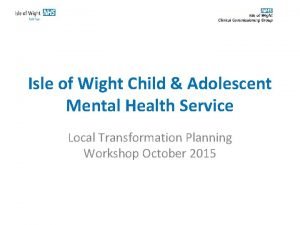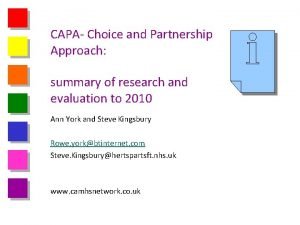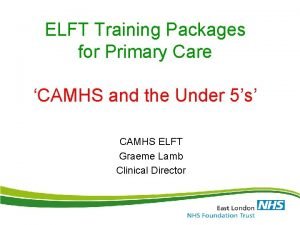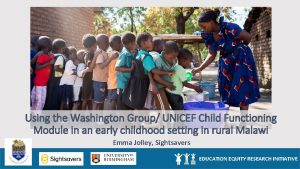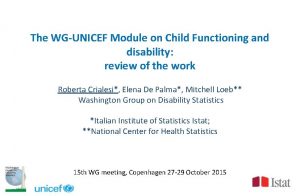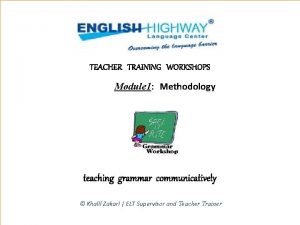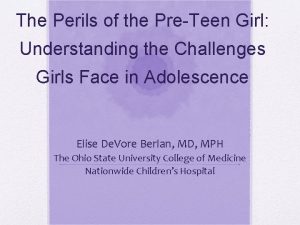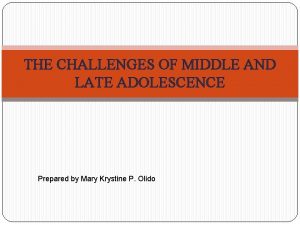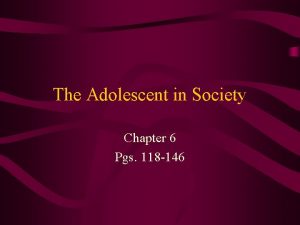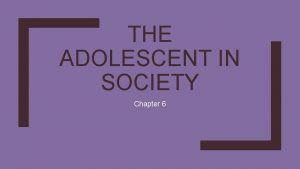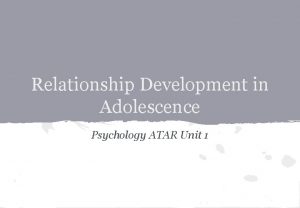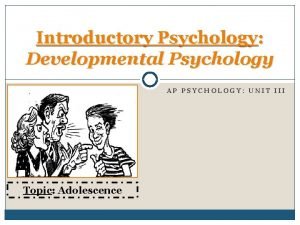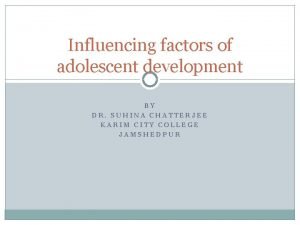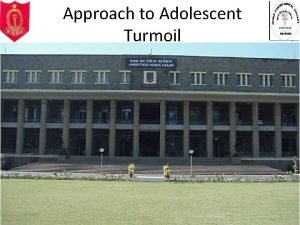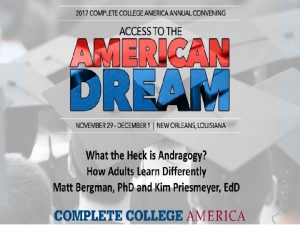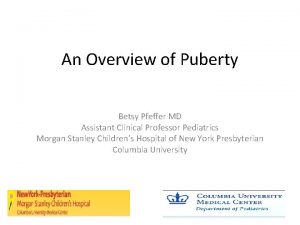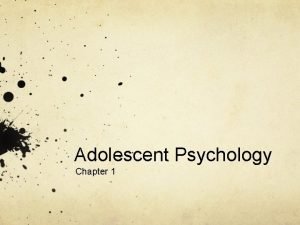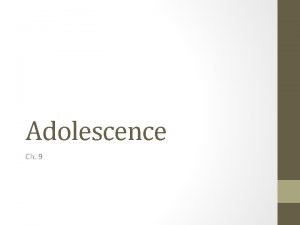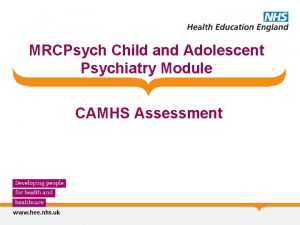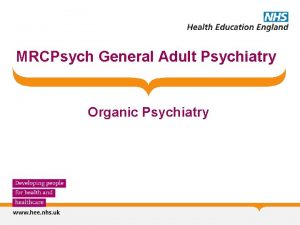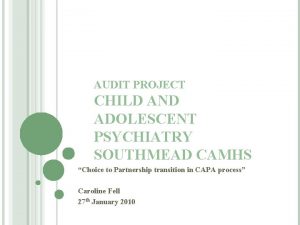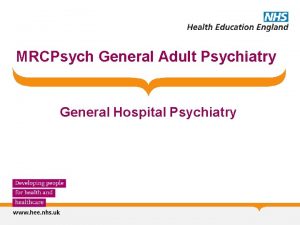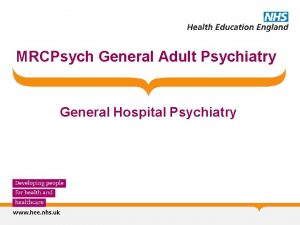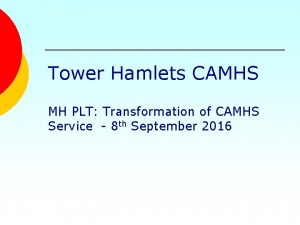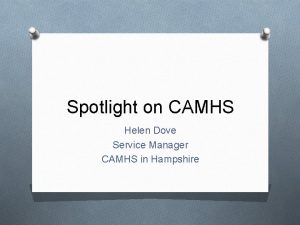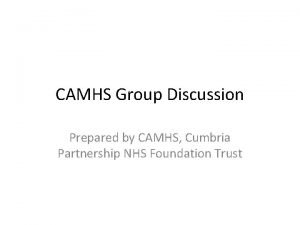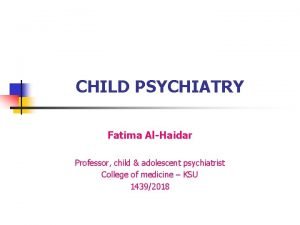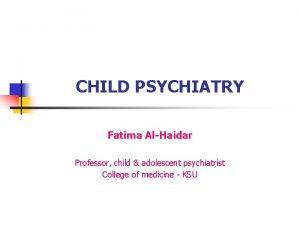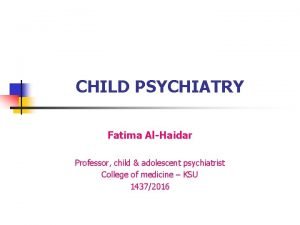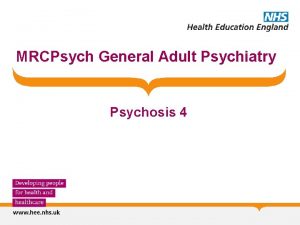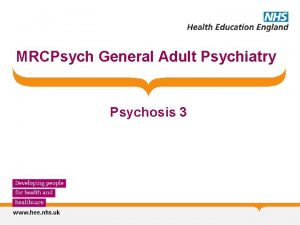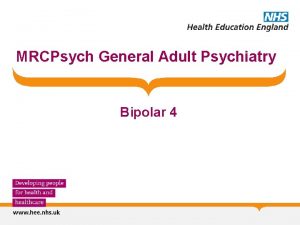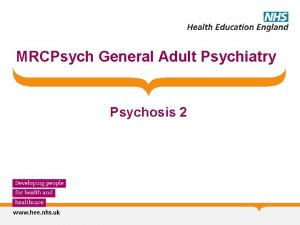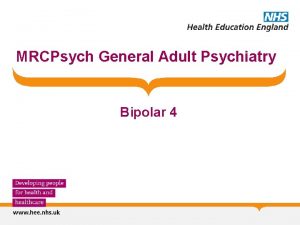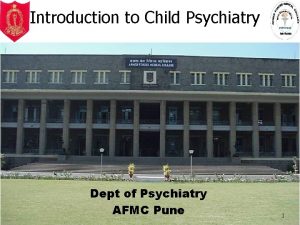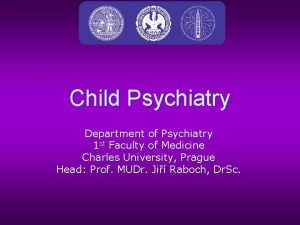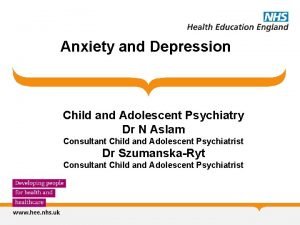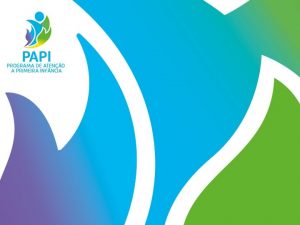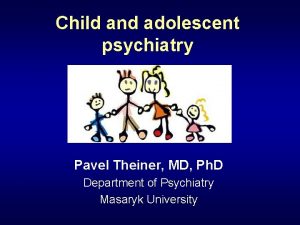MRCPsych Child and Adolescent Psychiatry Module CAMHS Assessment
























































- Slides: 56

MRCPsych Child and Adolescent Psychiatry Module CAMHS Assessment

CAMHS Assessment Aims and Objectives • The overall aim is for the trainee to gain an overview of the assessment in CAMHS • By the end of the session trainees should: – Undertake assessments of children and young people; to communicate effectively with children and young people across the age range; to take a developmental history; to formulate and prepare a plan and identify appropriate interventions. – Describe how the emphasis of assessments in CAMHS may be different to that in Adult Mental Health.

CAMHS Assessment To achieve this • • • Case Presentation Journal Club 555 Presentation Expert-Led Session MCQs • Please sign the register and complete the feedback

CAMHS Module Expert Led Session Assessment in CAMHS Dr Tim Morris Consultant Child and Adolescent Psychiatrist East Lancashire Child & Adolescent Service


What Is Child And Adolescent Psychiatry?

How Do We Work? • The service is typically delivered in a multidisciplinary style on an out-patient, day-patient or in-patient basis from hospital departments or the community • Important members of the Professional MDT include: – Psychiatrists, nurses, social workers, clinical psychologists, specialized therapist with some extended teams including OT and SALT with links to other professionals’ eg teachers, voluntary agencies, paediatricians, probation services. • Clinical assessment and diagnosis is based on the clinician’s integration of subjective information including direct observation and reports from parents, teachers and young people and the MDT. • A developmental perspective must be taken.

� Brain Development - The Critical Years • First 2 years - baby’s brain grows from 25% to 80% of adult size • Development continues in childhood learning empathy, trust and community

Summary of Parallel Developments During Adolescence

Types of disorder • Classification systems - World Health Organisation (ICD 10 – ICD 11 by 2022) and DSM 5 (also think RDo. C) • Many disorders seen in adults present for the first time in childhood.

History taking • Foundation for a thorough assessment is to take a detailed history (as in the rest of psychiatry). • You have transferrable skills from assessment in adult psychiatry, but the emphasis may be different. • The history is often predominantly obtained from an informant (parent) but don’t forget to ask the child and young person as well. May have a different emphasis. • Presenting complaint – ? from whose perspective – E. g. parent may complain of disruptive behavior and young person may describe being low in mood and irritable.

First Interview with Patient & Family • The first interview may take up to l½ hours • It is important to meet with both parents if possible, along with the child initially • If assessing an adolescent, you may wish to see the adolescent before seeing the parents (but should see on own at some point) • A younger child may not wish to separate from their parents at the first interview • The first appointment should help the clinician have an appreciation of: – The presenting difficulties, their severity and impact on the family or wider society e. g. school – What factors may have triggered, exacerbated or maintained the presenting problems – The strengths of the family and child and whether they are motivated to working on the issues – The expectations and ideas that the family have about being seen by CAMHS (goals of coming)

Recent behaviour /emotional state • • Being disobedient, destructive, defiant, having tempertantrums, telling lies, fire setting, stealing, taking drugs or alcohol, smoking, cruelty to animals/young children. Happy or miserable, crying often worries Anxious, school refusal Suicidal thoughts or acts of self-harm Routines, rituals, obsessions, fussy Does this occur at home or outside (school) or both. Solitary or accompanied How is it dealt with?

Health/Past Medical History • • • Is he/she off school at all? Generally healthy? ROS – – – • Asthma, headaches, stomachaches, eyesight, hearing, fainting, fits, absences Childhood infections and Immunisations Allergies, drugs, food Eating difficulties – • Food refusal, faddiness, feeding problems Sleeping problems – • settling, waking, nightmares, sleeping arrangements, when slept alone PMH – Illnesses, operations, hospitalisations

Family History • • Persons in home – age, religion, occupation, education, current mental/ physical illness, personality, seen by psychiatrist Details of parents own childhood and family support network Family history of psychiatric disorders or other illness Family life and relationships • Domestic conflict or violence/extent of childhood exposure to violence – Parental relationships – how do they get on? How do they spend evenings, weekends? To what extent do they both participate in childcare, discipline etc? – Parent-child interaction – Child’s participation in family activities – helps at home etc. – Rules and routines at home.

Personal History/Developmental History • • • Pregnancy – planned, complications, alcohol, smoking, drugs (previous pregnancies) Delivery – spontaneous/induced, place, date, labour, presentation, mode of delivery, gestation, birth weight, complications, resuscitation/SCBU Mother’s health during and after pregnancy - depression (PND) Neonatal period – breathing, feeding, convulsions, jaundice, and infections, how long in hospital? Infancy – feeding, weaning, sleep pattern, placid or active, irritable, easy or difficult temperament. Any behavioral difficulties e. g. tantrums as a toddler

Personal History Milestones sitting unsupported, walking unaided, first word with meaning, first 2 word phrases, and comparison with siblings, pointing Bladder and bowel control dry by day and night, bowel control. Separations apart from parents. How child reacted on separation for nursery/toddler playgroup, children's parties Interactions with peers as a young child Useful to use links to specific ages e. g. 4 -5 years “when they started infant school how did things go? ”

School • Present & Previous Schools – – – • happy, progress, and contact with school Attendance Academic strengths & weaknesses. Non-academic skills, independence Social relationships, Behaviour Support or learning support service, SENCO Educational Psychologist. Relationships – with other adults, with teachers, other children, opposite sex

Social history • Home circumstances – • Other care arrangements – • Child minder, baby sitter Finances – • description of the house, sleeping arrangements, community, overcrowding. any difficulties Neighbourhood – description of area, house moves, community violence, neighbour disputes

Personality/Temperament • Meeting new people – other adults, children, shy, clingy, how quickly does he/she adapt to change? New situations • – • Emotional expression – • introvert, extrovert, generally happy/miserable Affection & Relationships – • how does he/she show feelings, affectionate, confiding, friendships: school, at home Sensitivity – • new places, new tools, explore or hand back. response to person/animal hurt, reaction if told off, did something wrong Interests, hobbies

Interview with Child & MSE • Determined by the child’s age and developmental level • Provide the right materials (crayons, paper, books) and a safe and private environment • Initially, talk about neutral topics or things which the child or adolescent is interested in • It is important that you explain to the child that the interview is confidential and the limits of that confidentiality • With younger children you may wish to encourage the child to play with toys, draw or describe their family, friends or school • Approach discussion of feelings later on • With an adolescent, the interviewer may involve more direct questions and more of a verbal interchange • By the end of the interview you should have a reasonable idea about the child’s understanding of why they are being seen and some idea of their emotional state

Mental state examination • Appearance and behaviour: dress, physical appearance, motor activity, co-ordination, involuntary movements – Social response to interviewer: humour, rapport, eye contact, empathy, and co -operation, shy, confident – Social interaction with parents • Language: expression, comprehension, speech – spontaneous, quantity, rate, rhythm, and complexity • Mood: subjective, objective, symptoms/signs of depression, suicidal feelings, anxiety, panic, anger, aggression, and irritability • Abnormal beliefs, experiences, thought content, hallucinations, delusions, worries, fears, preoccupations, obsessions, fantasies or wishes • Cognition: attention span/distractibility, draw a person (note grip, handedness), write name, give days of week, months of year, counting, simple arithmetic, orientation, memory, general knowledge, reading skills/level of attainment

*Other sources of Information • School with appropriate consent • Undertaking school assessment with appropriate consent • Undertaking home observations

Assessment Tools- there are many • Questionnaires – SDQ/RCADS – Connors/SNAP IV/ CBCL Psychometrics - WISC Observational – ADOS Structures interviews KIDDIE SADS/ADI/DISCO

Risk Assessment • Factors – Historical – what has happened in the past – Clinical – what disorder the child has – Social – deprivation/family/school/drugs – Demographic – gender/age – Developmental – stage/delay

Trauma is HIGHLY PREVALENT • • Psychological - 11. 1% Physical – 10. 8% Sexual – 22% Witnessed domestic violence to mother – 12. 5% • Most common: substance use in household – 25. 6% • Overall response rate to any category – 52. 1%

Clinical trauma Screening • “What is the scariest thing that has ever happened to you? ” – “Has anything scary or upsetting happened since our last visit? ” (add to your family/child if asking parents) – “Do you know of any traumatic experiences your child has gone through? ” – “Has there ever been a time when you were (your child was) scared for your (his or her) life? ” – “Has anyone ever touched you in ways you did not want to be touched? ” • “Does [known traumatic event] ever bother or upset you these days? ”

Diagnosis What is a diagnosis ? Is it real? Is it useful? Is it flexible? Is it defensible or reproducible? Does it predict treatment?

Formulation • This is a brief description of the child’s presenting problems. It helps to consider the factors under: – BIOLOGICAL – PSYCHOLOGICAL – SOCIAL • PREDISPOSING / PRECIPITATING / MAINTAINING / PROTECTIVE • The formulation is useful in helping to highlight areas for intervention and producing a management plan with a description of the likely prognosis

CAMHS Module Any Questions? MCQs on the next slide

CAMHS Module MCQs • Patient should routinely have a neurological examination if they present with all except: A. B. C. D. E. History of an episode of fainting History of seizures Developmental delay Dysmorphic features Abnormal gait

CAMHS Module MCQs • Patient should routinely have a neurological examination if they present with all except: A. B. C. D. E. History of an episode of fainting History of seizures Developmental delay Dysmorphic features Abnormal gait

CAMHS Module MCQs • A physical risk assessment for patients with Anorexia Nervosa should include all except: A. B. C. D. E. Assessment of BMI and weight Assessment of heart rate Assessment of temperature Assessment of hydration status Assessment of body fat percentage abnormalities

CAMHS Module MCQs • A physical risk assessment for patients with Anorexia Nervosa should include all except: A. B. C. D. E. Assessment of BMI and weight Assessment of heart rate Assessment of temperature Assessment of hydration status Assessment of Body fat percentage

CAMHS Module MCQs • During an assessment of a 14 year old patient with depression in primary care, which of the following would prompt you to refer to tier 2 or 3 CAMHS: A. Mild depression in those who have not responded to interventions in tier 1 after 2 -3 months B. Active suicidal plans C. Referral requested by the young person D. Moderate to severe depression E. All of the above

CAMHS Module MCQs • During an assessment of a 14 year old patient with depression in primary care, which of the following would prompt you to refer to tier 2 or 3 CAMHS: A. Mild depression in those who have not responded to interventions in tier 1 after 2 -3 months B. Active suicidal plans C. Referral requested by the young person D. Moderate to severe depression E. All of the above

CAMHS Module MCQs • Assessment of ADHD commonly include all except: A. B. C. D. E. ADOS School observations History from parents/carers Connors assessment History from patient

CAMHS Module MCQs • Assessment of ADHD commonly include all except: A. B. C. D. E. ADOS School observations History from parents/carers Connors assessment History from patient

CAMHS Module MCQs • Mental state examination of a 15 year old patient should include all the following except: A. B. C. D. E. Assessment of appearance and behaviour Family history Assessment of speech Assessment of insight Assessment of cognition

CAMHS Module MCQs • Mental state examination of a 15 year old patient should include all the following except: A. B. C. D. E. Assessment of appearance and behaviour Family history Assessment of speech Assessment of insight Assessment of cognition

CAMHS Module MCQs • An assessment of a 3 year old with suspected Autistic Spectrum Disorder must include: A. B. C. D. E. A home visit A detailed mental state examination Observation of the child interacting with others All of the above A-C None of the above A-C

CAMHS Module MCQs • An assessment of a 3 year old with suspected Autistic Spectrum Disorder must include: A. B. C. D. E. A home visit A detailed mental state examination Observation of the child interacting with others All of the above A-C None of the above A-C

CAMHS Module MCQs • CAMHS assessments in patients with speech delay should routinely include all except: A. B. C. D. E. Family tree Family history of ASD/Aspergers Developmental history Details of whether the patient had the combined MMR vaccine Medical history

CAMHS Module MCQs • CAMHS assessments in patients with speech delay should routinely include all except: A. B. C. D. Family tree Family history of ASD/Aspergers Developmental history Details of whether the patient had the combined MMR vaccine E. Medical history

CAMHS Module MCQs • The presence of a disorder can be explained in terms of all except: A. B. C. D. E. Predisposing factors Precipitating factors Perpetuating factors Petulant factors Protective factors

CAMHS Module MCQs • The presence of a disorder can be explained in terms of all except: A. B. C. D. E. Predisposing factors Precipitating factors Perpetuating factors Petulant factors Protective factors

CAMHS Module MCQs • In regards to initial CAMHS assessment of children under 5 with speech delay: A. You should not see them without the presence of their parent/carer in the room B. You should aim to get the child sat down in a chair for the majority of the assessment C. You should observe them playing and play too if appropriate D. You should avoid difficult topics E. You should use more directed questioning

CAMHS Module MCQs • In regards to initial CAMHS assessment of children under 5 with speech delay: A. You should not see them without the presence of their parent/carer in the room B. You should aim to get the child sat down in a chair for the majority of the assessment C. You should observe them playing and play too if appropriate D. You should avoid difficult topics E. You should use more directed questioning

Mental health in the classroom

Typical case mix of cases presenting to CAMHS • 28% of CYP had mild problems or one moderate that doesn't fit NICE guidance. • 25% of CYP had multiple or severe problems that don’t fit easily into NICE guidance. Martin, P. , Davies, R. , Macdougall, A. , Ritchie, B. , Vostanis, P. , Whale, A. , & Wolpert, M. Developing a case mix classification for child and adolescent mental health services: the influence of presenting problems, complexity factors, and services on number of appointments. Considers impact of problems and complexity factors on service use

Prevalence (%) of childhood psychiatric disorders among those with and without a diagnosis of depression at 26 years of age * p <. 05 *Kim-Cohen, Caspi, Moffitt et al. (2003), Arch Gen Psychiat, 60, 709 -717

The Burden of Childhood Mental Disorder • Between 1: 10 and 1: 8 children and adolescents suffer from mental disorder severe enough to result in functional impairment • World Health Organisation Report: – Mental disorders will become one of the 5 most common causes of morbidity, mortality and disability among children

The Burden of Childhood Mental Disorder • Childhood mental disorders – Reduce the quality of children’s life – Diminish their productivity in later life – 75% of adult mental disorder anticipated by childhood disorder – No other illness damage so many children so seriously • Stigma continues to be a significant barrier to mental health treatment for children and their families despite public education

Transdiagnostic pathways from early social stress to psychopathology: a 20‐year prospective study Transdiagnostic pathways from early social stress to psychopathology: a 20 ‐year prospective study, Volume: 59, Issue: 8, Pages: 855 -862, First published: 08 January 2018, DOI: (10. 1111/jcpp. 12862)

When do mental health disorders emerge?

CAMHS Module Any Questions? Thank you
 Pediprn
Pediprn National network of child psychiatry access programs
National network of child psychiatry access programs Facilitating learning child and adolescent development
Facilitating learning child and adolescent development Infants, children and adolescents 8th edition
Infants, children and adolescents 8th edition Radical psychiatry sociology
Radical psychiatry sociology Mood mse
Mood mse Geriatric psychiatry definition
Geriatric psychiatry definition Forensic psychiatry vs forensic psychology
Forensic psychiatry vs forensic psychology Mse psychiatry
Mse psychiatry Surgery shelf percentile 2021
Surgery shelf percentile 2021 Cécile hanon
Cécile hanon Psychiatry in ethiopia
Psychiatry in ethiopia Jamaica hospital psychiatry residency
Jamaica hospital psychiatry residency Criminological psychology definition
Criminological psychology definition Addiction medicine expert witness
Addiction medicine expert witness Community geriatric psychiatry
Community geriatric psychiatry Core psychiatry
Core psychiatry Asclepiades father of psychiatry
Asclepiades father of psychiatry Feigned insanity forensic
Feigned insanity forensic Global initiative on psychiatry
Global initiative on psychiatry Camhs wirral
Camhs wirral Front doors tower hamlets
Front doors tower hamlets Pshe nedir
Pshe nedir Camhs competency framework
Camhs competency framework Camhs surrey phone number
Camhs surrey phone number Hillingdon camhs
Hillingdon camhs Camhs durham
Camhs durham Camhs hailsham
Camhs hailsham Ithrive model
Ithrive model Camhs isle of wight
Camhs isle of wight Mindsight camhs
Mindsight camhs Choice and partnership approach website
Choice and partnership approach website Camhs wirral
Camhs wirral Elft camhs
Elft camhs Camhs camden
Camhs camden C device module module 1
C device module module 1 Child functioning module
Child functioning module Child functioning module
Child functioning module Communicative grammar
Communicative grammar 패자트리
패자트리 Pre adolescent girl
Pre adolescent girl 3 filipino adolescent heroes
3 filipino adolescent heroes Undefined status adolescence
Undefined status adolescence Adolescence
Adolescence What is the difference between courting and dating
What is the difference between courting and dating Dexter dunphy 5 stages
Dexter dunphy 5 stages Adolescent age range psychology
Adolescent age range psychology What factors influence adolescent development
What factors influence adolescent development Erikson stages of development
Erikson stages of development Autonomy vs. shame and doubt
Autonomy vs. shame and doubt 4 identity statuses
4 identity statuses Adolescense period
Adolescense period Adolescent turmoil definition
Adolescent turmoil definition It is the art & science of helping adolescent learn
It is the art & science of helping adolescent learn Tanner scale
Tanner scale Adolescent generalization gap
Adolescent generalization gap Erikson's stage of adolescence
Erikson's stage of adolescence
